
|
|

October 14, 2005
KGO 810, Newark, California
By SCOTT FYBUSH
We've finally worked our way through most of the nifty sites we saw in June on our weeklong swing through New England, so beginning this week we'll turn our attention to the opposite coast, as we recap some of the highlights of a late-July visit to northern California, our first visit there in several years.
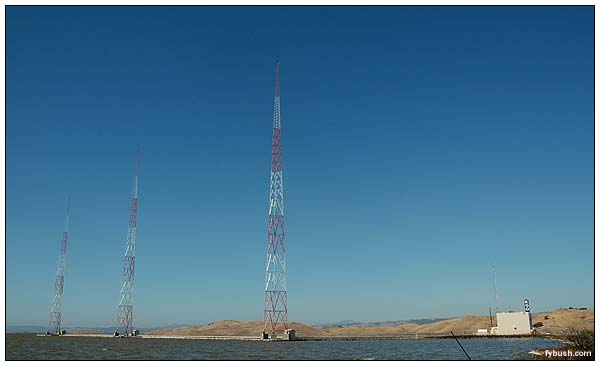
Our tower visits began just hours after we landed at San Francisco International Airport. From there, it's a fairly short drive south to the Dumbarton Bridge, the southernmost of the three major crossings that connect San Francisco and the peninsula to the East Bay. And it's impossible to cross the Dumbarton without noticing the three towers that guard its eastern end.
 This
is KGO, one of the biggest AM voices of San Francisco, and this
site (technically in the city of Newark, though it's often referred
to as being in Fremont) has been home to this 50 kW signal since
1947, when it moved south from its original home of Oakland.
This
is KGO, one of the biggest AM voices of San Francisco, and this
site (technically in the city of Newark, though it's often referred
to as being in Fremont) has been home to this 50 kW signal since
1947, when it moved south from its original home of Oakland.
(Some history? But of course - KGO signed on in 1924, one of the pioneering radio stations in the West and one of three stations owned by General Electric. By the end of 1924, KGO was running 1500 watts, making it one of the most powerful stations in America. It briefly edged its power up to 12.5 kW, but by 1928 it was operating on 790, sharing a frequency with GE's flagship station, WGY in Schenectady. That unusual duplication of what was supposed to be a clear channel limited KGO to 7500 watts, a power it would remain at until the construction of this facility, when it went to 50 kilowatts with a directional antenna to protect WGY. By then, of course, both stations were at 810 on the dial, where they remain to this day.
In 1929, NBC signed an agreement to manage and operate GE's stations, and KGO became the West Coast flagship for NBC's Blue Network, moving its studios across the Bay to San Francisco and the NBC headquarters on Sutter Street. That arrangement, which paired KGO with Red Network flagship KPO, lasted until the early 1940s, when NBC was forced to divest itself of the Blue Network and to end several such management agreements around the country.
KGO would end up as an owned-and-operated station of the Blue Network's successor, the American Broadcasting Company, and to this day the station remains one of the gems of the ABC network, with a record of ratings success that pretty much any other station would envy.
Today it's a live and local talk station, with a distinctively San Francisco lineup of hosts, a solid news department and well-equipped studios in ABC's building at 900 Front Street in San Francisco.)
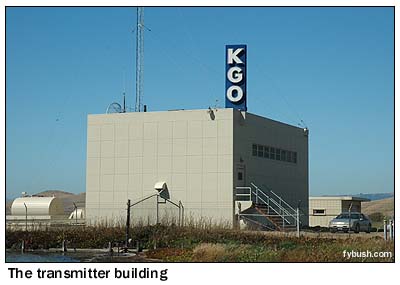 |
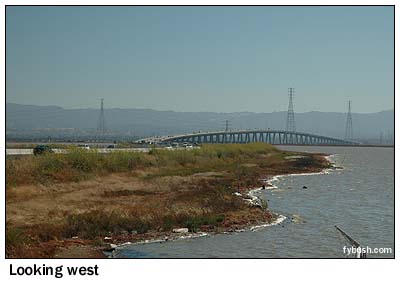 |
From the outside, the building looks much as it did in 1947, when it was erected at the edge of the salt flats that line the eastern shore of the bay just north of the bridge. Back then, the building sat on a frontage road that lined the bridge access road; later reconstruction eliminated the frontage road, and today the site is reached by passing through the tollbooths and then making a somewhat risky and rather abrupt right turn into the driveway.
That task accomplished, we enter the building through the front door, up steps that were recently replaced after a half-century in the salt air had done in the 1947 versions. The front door opens on a stairwell, and it's half a flight up to the main transmitter room.
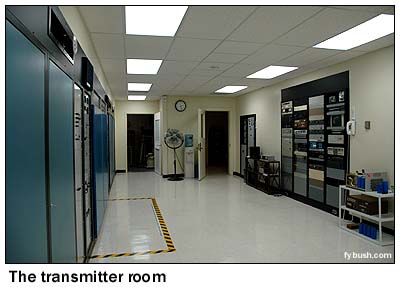 |
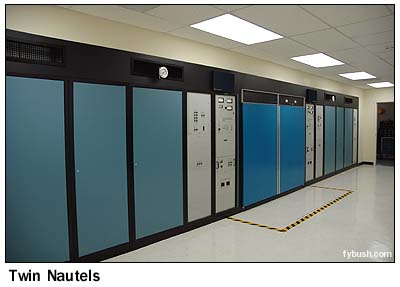 |
Walk up the stairs and you're immediately confronted by two things: perhaps the cleanest transmitter room floor we've ever seen, and a long row of cabinets that includes the two Nautels (Ampfet 50s, if memory serves) that serve as KGO's main transmitters, with the phasor in the center.
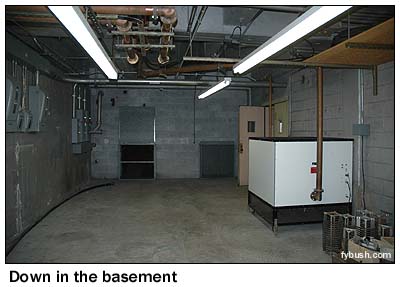 Note
the tape on the floor around the phasor: they're conscious of
RF safety here, and that tape tells you where not to stand when
the phasor cabinet is open.
Note
the tape on the floor around the phasor: they're conscious of
RF safety here, and that tape tells you where not to stand when
the phasor cabinet is open.
Across the room, next to the stairwell, there's a small workshop that runs across the front of the building, as well as the racks of STL and processing gear and a smaller Nautel backup transmitter. That's an office area through the door at the center of the picture, above - and the door to the left leads to the back of the transmitters.
Head downstairs and you're back into history, as it were. One of the rooms down there is filled with part of chief engineer Art Lebermann's collection of "boat anchor" receivers (in his spare time, he runs a side business that restores and sells vintage radios!), and beyond that is the plenum chamber that's used for filtering the air that comes into the building (one reason, perhaps, why that floor stays so clean). Above, we see the space directly below the transmitters. Once upon a time, this room was filled with huge power transformers, but today it's mostly empty, with just a dummy load to fill the space.
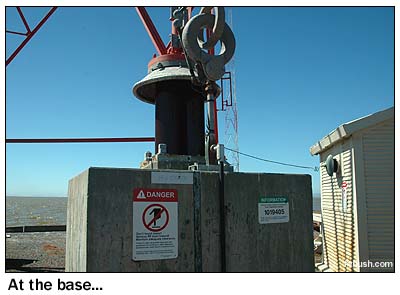 |
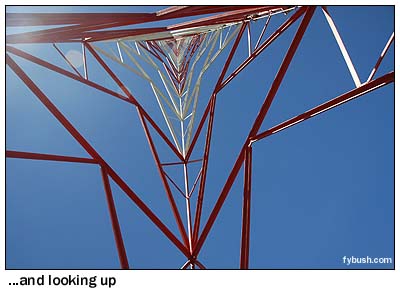 |
That's the building, more or less - but there's the matter of towers, still, and therein lies a tale. The original trio of 300-foot towers (the first directional array in the San Francisco market) suffered severe damage in the Loma Prieta earthquake of 1989, forcing KGO to replace them with three new self-supporters. The new towers are each 315 feet tall (90 degrees at KGO's 810 kHz frequency), and it's hard to argue with how well they work.
In a city known for good AM signals, KGO is one of the best. The location that the station picked in 1947 turned out to be prescient: from here, the salty water of the Bay - and the even saltier water that's concentrated around the tower bases - provides exceptional groundwave propagation not only to the northwest, into San Francisco itself, but also the the south, into what was then a backwater suburban area but what's now Silicon Valley. And the directional signal, a figure-eight designed to protect WGY and avoid wasting signal over the Pacific Ocean, has the helpful side effect of concentrating a massive signal up and down the coast. At night, KGO is a local-like signal in both Los Angeles and Portland, Oregon.
JUST RELEASED - it's your very first chance to order the 2006 Tower Site Calendar! Click here for ordering information!
- Previous Site of the Week: WTIC, Avon CT (part II)
- Next Week: A Trio of Northern California AMs
- Site of the Week INDEX!
- How can you help support Site of the Week? Click here!
- Submit your suggestions for a future Site of the Week!
